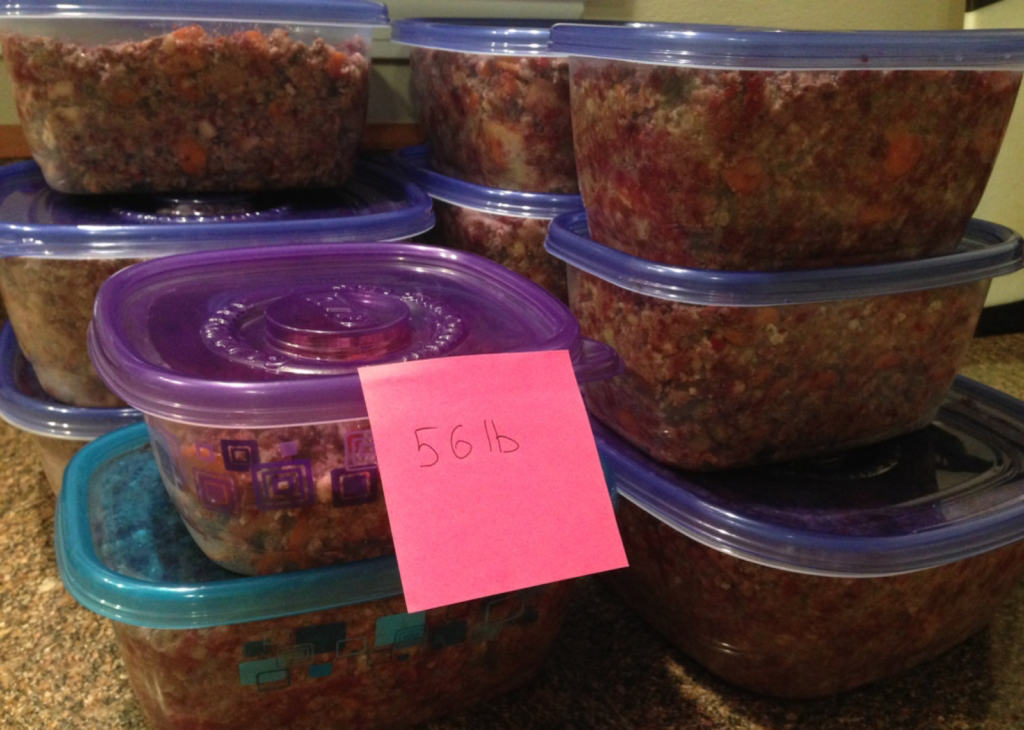
Growing up in Eastern Europe in 1980s – early 1990s – the term “dog food” didn’t exist. The best dog food was scraps from the table or homemade dog food. I remember establishing connections with local butchers to pickup weekly meat and bone leftovers from the market.
At the end of 1990s commercial dog food became more affordable and there were a few European and American brands available for sale. There was no doubt among fellow dog owners that the best dog food for our dogs was commercial dog food.
A monthly supply of imported kibble for a dog in Eastern Europe costed nearly a monthly salary. It was definitely a lot more expensive to switch to kibble, but most dog owners spare no expenses to ensure good care for their fury family members. Some of the most popular kibble brands were Royal Canine from France, and Pedigree Advanced from the US.
Shortly after kibble became a standard in healthy food choice among breeders and trainers, local (Eastern European) commercial brands emerged at a much lower cost. Cost was always an issue in my country, so buying an alternative kibble at a much lower price was a game changer. Breeders and trainers were becoming re-sellers, quickly switching more and more dog owners to the local brands of kibble. Within a year or two we began to notice tragic results of that new food trend. Dogs were dying from kidney failure.
Back then, no one could assume that kibble in general is not a suitable food for dogs. We blamed local brands and switched back to expensive imported brands.
20 years later, here in the US, what is the best dog food is a controversial topic. Majority of breeders and people in dog sport communities feed their dogs either raw or homemade diet. Majority of pet owners feed kibble. Why is that? I think because breeders and dog sport enthusiasts are more educated and concerned about health and longevity of their canine partners. They are not afraid to spend more time and more money to give their dogs what’s best for them. Pet owners might be as much considerate, but unfortunately less educated about options.
In 2013 when I was flying to the US from Poland with my first dobe puppy, I was carrying a bag of Royal Canine for puppies that I bought in Poland. My pup was crazy about that food. A week later, when I had to switch to Royal Canine bought at a local PetSmart, my puppy didn’t think it was edible. So, my education about dog food had begun.
I spent months trying to find kibble that my pup would eat and that wouldn’t cause digestive issues. Months after months, brand after brand – I was puzzled. A few months after arriving to the US, my pup developed food allergies, repeated skin (hot spots) and ear infections. I decided to start cooking for him as I used to do for my dogs 20 years ago. His health had improved, but my curiosity was demanding answers.
I spent months gathering information online (as I always do) – reading blogs, articles, magazine publications, and US government regulations about kibble. Commercial dog food is a massive money-making machine. Just like tobacco industry was doing for decades, commercial dog food manufacturers are denying any allegations about connection between kibble and dogs’ health issues. And this is the reason why there are so many dog food brands in the US. Not all of them are bad.
COMMERCIAL DRY FOOD.
The smaller, more family-like kibble manufacturer is – the more likely it to be more expensive, but with a better set of ingredients, higher quality control, and better preparation process. The more advertised the brand is – the more likely you should stay away from it.
What I’ve learned about kibble regulations in the US is that unless a dog dies within a first few days after consuming kibble – the food is approved to be sold. Think about it. Dogs live about 10 years on average. Most fatal diseases like cancer and kidney failure take years to develop from causes like food poisoning. If the dog is 7 or 8 years of age by the time it got sick – it is difficult to connect the disease to food quality. So what commercial kibble manufacturers do? They develop formulas that affect dogs slowly. Of course they don’t do it out of pure evil. The meat and real ingredients are expensive. Dog food companies have to run a profitable business.
I recommend to read an article about the history of commercial pet food industry in the US, written by Dr. Karen Becker, DVM from Chicago. This article will help you understand the reasons behind creating dry dog food in a first place and how it evolved.
There were a few criteria I used when researching kibble:
- first, the food should be available at the boutique pet stores. This is usually the indication that they’ve done the research for you already and hand-picked a few brands that they trust;
- second, there should be no food recalls for the brand you chose. I only cared for recalls related to food quality;
- third, no corn, wheat, rice as they are not natural ingredients for dogs – they can’t digest it;
- fourth, read customer reviews for each chosen brand on the online stores. I didn’t trust review sites as they gave high scores to brands that didn’t pass my first 3 criteria.
- fifth, pay close attention to the ingredients list on the label. At least first 12-15 ingredients should be real food, not some kind of filler or minerals;
- sixth, limited protein. It was important for me to limit proteins for my dog as he started to develop food allergies. If your dog is healthy – you can skip this step.
US regulations for dog food is much lower than in other countries. It prompted me to search for brands made outside the US. Canadian brands Orijen and Acana were recommended by several breeders and trainers from the US and Poland (where I got my dogs from). Acana and Orijen are manufactured by the same Canadian company Champion Petfoods. They use local fresh meat and ingredients that passed for “human consumption”, and have high quality control. When I was researching this food I didn’t find any recalls either.
Orijen and Acana are my #1 choice in kibble, but because of the limitations I had when my dog was developing food allergies, my choice for the best dog food was US brand Fromm. Though, I don’t feed my dogs kibble, I consider these 3 brands are the best dog food for Dobermans that has to be fed kibble.
Here is the list of dry dog food brands I’ve tried:
- Royal Canine – different list of ingredients and much lower quality in the US, than in Europe;
- Blue Buffalo – caused my pup severe diarrhea and dehydration, and has numerous quality recalls, but well advertised;
- Natural Balance – non-digestible, caused my dog to poop more than he was eating;
- Taste of the Wild – wasn’t too bad, but caused minor diarrhea and I had to move on;
- holistic brands that didn’t excite my pup or his digestive system: Holistic, Canidae, Zignature;
- Nutro – didn’t work for my pup, but I ended up feeding it to my adopted Chihuhua mix for several months until he stopped eating it;
- Fromm – was the best fit and didn’t cause any issues, but at that point I’ve decided to stop experimenting with kibble and started cooking.
CANNED FOOD.
If you can afford to spend more money on food, but don’t have time to cook or concerned about feeding raw, then I recommend feeding canned food. What I look for in the canned food, in addition to the listed above criteria, is absence of Carrageenan, Guar Gum and other ingredients that are not normal food. Canned food should only contain food and some kind of preservative. I prefer to have less ingredients in canned food as I’d rather add fresh veggies for needed vitamins and minerals.
My choice for the best dog food in cans is Evanger’s Grain-Free Hand Packed Braised Beef Chunks with Gravy. It looks and tastes like real braised beef (yes I’ve tried it myself), and it didn’t cause any digestive issues to my sensitive dog.
HOMEMADE AND RAW.
If you decide to cook for your dog, I recommend checking homemade dog food blog and Dr. Karen Becker recipes. On my opinion, any homemade food is way better than any kibble. And if you add fish oil, calcium, B complex, and Vitamin E supplements to the diet – your dog will get what he needs to stay healthy.
I was feeding my dogs homemade diet for almost 2 years. My dogs had a lot of exercise in training and competitions. The only problem I had with the homemade diet is that I wanted my dogs to gain a bit more weight. Their weight were 73 lb and 78 lb. They weren’t underweight, but I wanted them a bit heavier.
I cooked once a week about 60 lb of food for 2 dogs. My recipe was simple. I boiled beef shank and femur bones for 5-6 hours with a bit of vinegar (to help extract minerals). Then I added some potatoes and spaghetti (my dogs needed carbs to maintain weight), let it boil for 5-10 minutes. Add meat and various veggies, let it boil for a few minutes and it’s done. Below is my recipe in photos. Please, keep in mind this is low protein diet for one of my dogs that had protein restrictions:
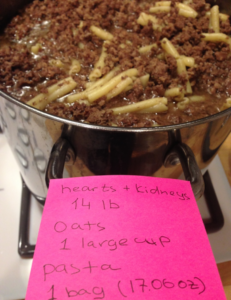
1. 14 lb of lean meat (no fat). 1 cup of oats to soak up extra liquid. 1 bag of pasta (or rice, or potatoes) to add carbs if you need to put weight on your dog. Every week I use different mix of meat – organs vs muscle meat.
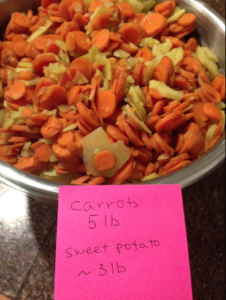
2. Slightly cooked veggies. Every week I use different set of veggies – broccoli, spinach, cauliflower, pumpkin, squash, green beans. Costco has best prices. If your dog has yeast infection – avoid veggies with high sugar.

Berries are a good source of vitamins, so I add them at the end of cooking to let it steam only (no boiling). I buy them frozen from Costco. But don’t add too much of it, otherwise your soup will start brewing.
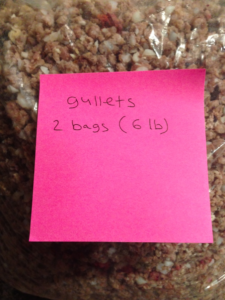
Gullets are a great source of cartilage. They are cooked and I always add them to the mix. Since cooked bones are dangerous for dogs, I feed steamed or raw femur bones to my dogs twice a week.
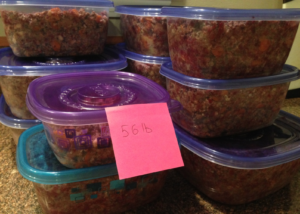
And finally – all ingredients mixed together. 56 lb of food for 2 dobermans for a week: 16 lb of meat/cartilage, 12 lb of veggies, 1 bag of pasta, 1 cup of oats. Please note – this is a low protein diet due to restrictions I had with one of my dogs.
I came across an online store from Colorado that sells homemade food. They make it easier for you. Check them out at pack10natural.com.
And lastly, I think raw diet is the best for your dog. I was concerned about bacteria and infections and was feeding my dogs cooked food for nearly 2 years before I decided to give raw diet a try. And I was amazed with transformation of my dogs – energy level, coat, teeth, ability to bulk up. I feed raw for 9 months now. I don’t think I will ever switch back to cooking. Feeding raw is less hassle (comparing to cooking), noticeably better for your dog’s health. I consider the best dog food ever is the one they were designed by nature to eat – raw meat.
There are a lot of information online about how to feed raw, what proportions, etc. I found that you have to watch your dog and make adjustments to his or her body. For example, one of the site had a calculator how much you should feed your dog. I had to triple that amount for my active dog. And I give only half of the suggested amount to my older Chihuahua mix. I was also running blood and urine tests on my dog before and after introducing raw food. I noticed that too much protein was causing dull coat and slightly increased protein levels in his urine. Finding a good balance in diet is custom to each dog, but there are some good guidelines to begin with you can find online. I particularly liked this website – perfectly rawsome.
My 2.5 years old intact male doberman weighs 83 pounds and he is a high energy dog. He doesn’t have any diet restrictions. I train 3 times per week for Schutzhund (IPO), once or twice a week we do a bike ride. My recipe for his raw diet is simple: 1lb of mixed raw meat + 1 cup of The Honest Kitchen Preference mix (it’s dehydrated mix of fruits and vegetables). Twice a day. I also give him raw fish, liver and bones during the week. All meats are previously frozen.
If you are in Northern California near the bay area, I recommend buying meats from Excel Pet Pantry. They have necessary selection of organs, bones, and muscle meat you would want to feed your dog. And their prices the lowest I’ve found. You will need to buy a freezer as Excel Pet Pantry delivers once a month.
Fruits and vegetables you can buy at a local store, blend them and add to dog’s meals. Buying dehydrated mix is more convenient for me. You can buy The Honest Kitchen (and variety of other boutique manufactured dog foods) from the same place – Excel Pet Pantry. Owner – Renee – constantly bringing new, health-conscience brands to her online store. Or you can check chewy.com – my favorite online dog shop for everything pet-related.


